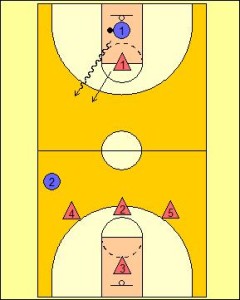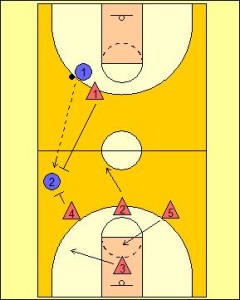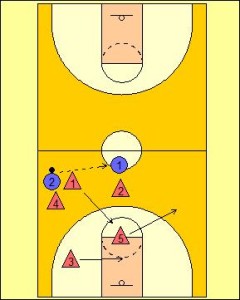1-3-1 Push Wing Trap
The 1-3-1 Push Wing Trap is a half court pressing system. The focus of the defence is to initiate trapping areas above the quarter court, but well within the halfway line.
This position of the 1-3-1 Push Wing Trap helps reduce the distance needing to be covered by the defenders in rotation. This also pushes the half-court offense of the opposition out of their desired positioning so they are forced to alter their receiver spots.
This in turn forces the offense to move away from the basket or make longer, slower passes between offensive players. These two points only serve to make the 1-3-1 Push Wing Trap very effective as a change-up defence.
While the 1-3-1 Push Wing Trap is not suitable to be used for an extended period of time sparingly used throughout a game it can be very effective at disrupting an offense.

The formation sees the top player in the 1-3-1 Push Wing Trap extends to the backcourt foul line. This player is looking to channel the dribbler to a sideline, but this is not mandatory. The key here is for the ball to just be slowed in its progression up the floor.
The players fielding positions within the middle of the defence (One, Two and Three) are usually the quickest players on the team. This will help in rotating during the defences required movements.
By having the interior players on the wings (Four and Five) once the trap is initiated the rotations will see one of these players protecting the basket and in a strong rebounding position.
The three defenders in a line (Four, Two, and Five) look to push the offensive receivers out of the quarter court area. If these defenders remain in a line across the court, it will appear as though there is little opportunity for a pass over them. This important in providing the illusion of limiting the options available to the offense.
The remaining player (Three) remains on the basket looking to defend the direct pass to an offensive player in the keyway or if the pass is particularly poor, they might also be able to intercept a pass over the three defenders ahead down the sideline if the offense looks to this option.

The shorter the pass by the dribbler the quicker the on-ball defender (One) can complete the trap with the wing player (Four).
It is vital for the on-ball defender to not get beaten off the dribble and to try and jockey the ball handler for as long as possible to shorten the distance for the run into the trapping action.
When the trap is initiated all the remaining defensive players (Two, Three and Five) rotate closer to the ball to limit the passing options by the offensive wing player.
Two (2) lifts up the floor to deny a pass back towards the middle lane.
Three (3) rotates to the strong side sideline to limit a pass down the wing. If there is no player in this position Three (3) will remain on the strong side edge of the keyway.
Five (5) rotates towards the basket at the split line. Five (5) will be responsible for any offensive players flashing on the inside shoulder of Two (2) or Three (3).
Two (2) and Three (3) are in full denial of an offensive player within their areas of responsibility. They should be in a position relative to the ball of; ball, defender, offensive player.
Five (5) however halve deny any offensive player. This should be from under the player (baseline side).

If the offense is able to initiate a pass back to the middle of the floor. The guard involved in the trapping situation (One) will rotate behind the player (Two) now guarding the ball.
Five (5) relocates back to the wing position.
Three (3) moves back to defending the basket.
This will allow for the 1-3-1 Push Wing Trap to reset and trap again on either side of the floor.
Once the ball has crossed halfway and a trap has been initiated. If the wing players find themselves with no player to guard they can sink down and into the inside of the three-point line to help condense the defence.
If the ball is passed down the sideline during any of the possible trapping sequences, standard 1-3-1 Zone Defence principles apply.
By employing this tactic the 1-3-1 Push Wing Trap can be used as a variation for a team using a 1-3-1 Zone Defence without any problems.
Related articles







